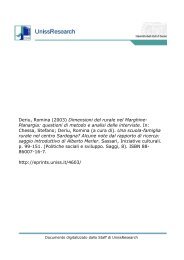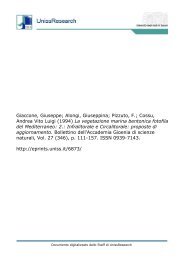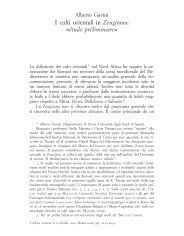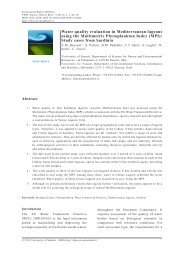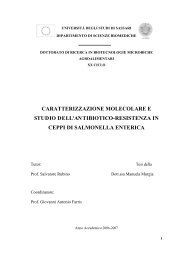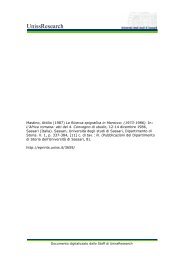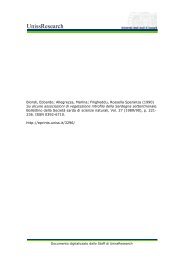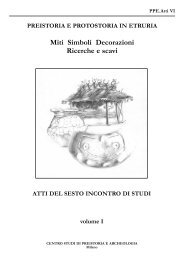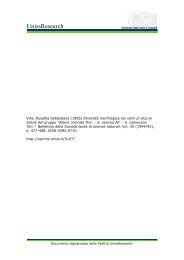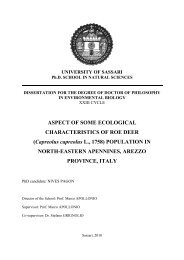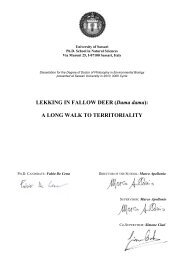L'Africa romana - UnissResearch - Università degli Studi di Sassari
L'Africa romana - UnissResearch - Università degli Studi di Sassari
L'Africa romana - UnissResearch - Università degli Studi di Sassari
You also want an ePaper? Increase the reach of your titles
YUMPU automatically turns print PDFs into web optimized ePapers that Google loves.
276 Andreina Magioncalda<br />
e si può calcolare che fosse <strong>di</strong> 50.000/60.000 sesterzi quella <strong>di</strong> Uthina S8 •<br />
Di 100.000 se sterzi erano, invece, le fondazioni <strong>di</strong> Hippo Regius e Thugga:<br />
però, come si è visto, le ren<strong>di</strong>te andavano a beneficio non solo delle<br />
curie, ma anche dei decurioni e <strong>degli</strong> Augustali, nel primo caso, dei decurioni<br />
e del popolo, nel secondo s9 • Perciò, il confronto con le testimonianze<br />
da Theveste e da Uthina permette <strong>di</strong> pensare che l'ammontare della<br />
liberalità <strong>di</strong> Martialis rientrasse nella consuetu<strong>di</strong>ne 60 •<br />
Non sappiamo a quale interesse doveva essere impiegato il capitale,<br />
infatti questo particolare, che anche per le altre fondazioni africane risulta<br />
solo in casi rari 61 , nell'iscrizione <strong>di</strong> Mactar è omesso. Si può pensare<br />
al 5 % o 6070, tassi che, se guar<strong>di</strong>amo la documentazione proveniente<br />
soprattutto dall'Italia, per le somme me<strong>di</strong>e e alte sono i più comuni 62 •<br />
La prima ipotesi è forse più probabile, se si considera che il 6% in Africa<br />
si incontra per un capitale <strong>di</strong> 4.000 sesterzi 63 • Quin<strong>di</strong>, per l'epulati-<br />
S8 Supra, p. 273 e nt. 47 e v. infra, p. 278 e nt. 70. In questo caso "epigrafe non in<strong>di</strong>ca<br />
"intero capitale ma la quota annua spettante ad ogni curia.<br />
S9 Supra, p. 273 e ntt. 44, 45. Per un calcolo (del tutto ipotetico) <strong>di</strong> quanto sarebbe<br />
toccato alle curie, v. infra, nt. 83. Particolare è la fondazione <strong>di</strong> Abthugni (supra, p. 273<br />
e nt. 46), della quale erano beneficiari i decurioni e le curie: in essa il capitale ammontava<br />
a 22.000 sesterzi e le ren<strong>di</strong>te dovevano essere <strong>di</strong>stribuite ogni 7 anni (anziché annualmente,<br />
come <strong>di</strong> consueto): v. infra, nt. 101, per il calcolo delle ren<strong>di</strong>te, che, probabilmente, spettavano<br />
alle curie.<br />
60 Un altro caso analogo potrebbe essere quello della fondazione <strong>di</strong> Hadrumetum,<br />
se, come si è ipotizzato (supra, nt. 55), era destinata alle curie. Poiché, infatti, essa ammontava<br />
a Il.000 sesterzi e poiché le <strong>di</strong>stribuzioni dovevano avvenire quinto quoque anno,<br />
il DUNCAN-JONES, Economy2, p. 118, ad n. 264, osserva che questo capitale «is comparable<br />
with a normal capitaI of HS 55,000-44,000» (secondo lo stu<strong>di</strong>oso, sarebbe anche<br />
possibile che, previa una rilettura dell'epigrafe, la vera cifra fosse «XL», ossia 40.000 sesterzi).<br />
61 CIL VIII 1641, cfr. pp. 1523, 2707 (= ILS 6818) = I. Bardo 367 (b) (da Sicca),<br />
r. 4 s.: ut ex usuris eius summae quincuncibus (50/0); CIL VIII 12421, cfr. p. 2432 (= ILS<br />
5071) (cfr. ILTun. 766) (da Oor), r. 6 s.: ut ex eius summae (sciI. 4.000 sesterzi) re<strong>di</strong>tum<br />
(sic) id est usurae *" LX (il tasso, è, dunque, del 6%); CIL VIII 1845, cfr. 16501 (= ILS<br />
6837) = ILAlg. I 3017 (da Theveste), r. 5 s.: ex quorum usuris centesimo (12%) (cfr.<br />
DUNCAN-JONES, Economy2, pp. 102-103, nn. *248,267,268; v., inoltre, pp. 81, 135). Il<br />
tasso era probabilmente del 5% anche nella fondazione <strong>di</strong> Abthugni: v. infra, nt. 101. Lo<br />
stesso sarebbe anche ad Auzia: DUNCAN-JONES, op. cit., p. 116 s., ad n. 258 (e, in precedenza,<br />
lo., Costs, p. 62 nt. 44, dove proponeva il 5% anche per la fondazione da Theveste<br />
n. *250). Che "interesse fosse del 6% ad Hadrumetum <strong>di</strong>ce A. BOURGAREL-Musso, Recherches<br />
économiques sur l'Afrique romaine, in «R. Afr.», 75, 1934, p. 408, del 5% a p. 518.<br />
62 V. DUNCAN-JONES, Economy2, pp. 133-136, in partic. 134-135.1112% si trova generalmente<br />
per i piccoli capitali. Il massimo attestato è del 15%, del quale resta un solo<br />
. esempio, per un capitale minimo: v. DUNCAN-JONES, op. cit., pp. 134, 135 (tabella).<br />
63 Cfr. supra, nt. 61. DUNCAN-JONES, Economy2, p. 104, n. 275 (= 255) (e cfr. lo.,<br />
Costs, p. 62 e nt. 44). Anche il RAMIREZ SAOABA, Oastos, p. 33 s. nt. 22, si attiene al 5%<br />
(seguendo il Duncan-Jones).<br />
L'epigrafe da Mactar <strong>di</strong> C. Sextius Martialis 277<br />
cium previsto a loro favore da Martialis, le curie avrebbero usufruito ogni<br />
anno <strong>di</strong> 2.500 sesterzi. Su questa base, seppure in via ipotetica, si può<br />
calcolare quanto doveva costare il banchetto per ogni curia. Infatti, grazie<br />
al fortunato ritrovamento <strong>di</strong> un'altra epigrafe da Mactar, della quale,<br />
tempo fa, ha dato notizÌa il Picard 64 e, per quanto mi risulta, tuttora<br />
ine<strong>di</strong>ta, sappiamo che le curie, il cui numero nelle città africane non era<br />
fisso, a Mactaris erano 10 6s • Il documento, una de<strong>di</strong>ca <strong>di</strong> età severiana<br />
in onore della famiglia imperiale, commemorante la costruzione <strong>di</strong> un<br />
e<strong>di</strong>ficio, presenta anche un particolare interesse, perché ricorda che, in<br />
quell'occasione, ogni curia aveva ricevuto da un benefattore un'elargizione<br />
<strong>di</strong> 2 aurei (= 200 sesterzi), a titolo <strong>di</strong> epulaticium 66 • Dunque, poiché<br />
a Mactar vi erano lO curie, il banchetto, che Martialis aveva istituito<br />
in memoria del fratello, aveva per ognuna <strong>di</strong> esse un valore presumibile<br />
64 V. infra, nt. 66.<br />
65 Generalmente ne sono attestate fino a lO o Il: lO, oltre che a Mactaris, ad Althiburos<br />
e a Lambaesis (CI L VIII 16472; CIL VIII, p. 283), 11 a Thuburbo Maius, a Lepcis<br />
Magna (ILTun. 728; IRTrip., p. 263 (index ix) e cfr. AE 1950, 162) e, a quanto sembra,<br />
a Theveste (v. G.-CH. PICARO, Isaona, in «R. Afr.», 100, 1956, p. 310 s. e nt. 34, in base<br />
a ILAlg. 13097); almeno lO erano a Mopth ... (AE 1942-43, 58). V. DUNCAN-JONES, Costs,<br />
p. 73 (cfr. lo., Wealth, p. 171); lo., Economy2, p. 282 e nt. 5 e cfr. p. 281, il quale pensa<br />
che il numero standard per città fosse <strong>di</strong> lO o 11 curie. Al riguardo v., inoltre, KOTULA,<br />
Curies municipales, in partic. p. 63 s. (ivi, nt. 45, dubbi sul numero <strong>di</strong> Il curie a Theveste)<br />
e p. 67 (cfr. pp. 34, 35 nt. 66, 37, 39, 42); M. TORELLI, Le Curiae <strong>di</strong> Leptis Magna, in<br />
«QAL», 6, 1971, pp. 105-111 (ivi anche per le curie <strong>di</strong> Lambesi); T. KOTULA, Nouvelles<br />
observations sur les «portes» de Thugga et sur les curies municipales en Afrique romaine,<br />
in «KIio», 54, 1972, p. 236 s. e nt. 34 (a proposito <strong>di</strong> Mopth ... ); GASCOU, La politique<br />
(1), p. 59 e nt. 3 e p. 153; KOTULA, Curies africaines, p. 140; da ultimo, infine, F. JAC<br />
QUES, Quelques problèmes d'histoire municipale à la lumière de la lex Imitana, in «L'Afrique<br />
dans l'Occident romain (Ier sièc/e avo I.-C. - IVe sièc/e ap. I.-C.). Actes du colloque<br />
... (Rome, 3-5 décembre 1987)), Rome 1990, pp. 391-394 e nt. 39 (in partic., per le<br />
curie <strong>di</strong> Lepcis Magna e Lambaesis, che inizialmente sarebbero state 9, v. pp. 392-393 e<br />
cfr. p. 397).<br />
Probabilmente erano lO le curie <strong>di</strong> Abthugni e, forse (è solo un'ipotesi), Il quelle <strong>di</strong><br />
Hadrumetum: infra, ntt. 101, 83.<br />
66 V. G.-CH. PICARO, Lesfouilles de Mactar (Tunisie) 1970-1973, in «CRAI», 1974,<br />
p. 23, che non riporta il testo dell'iscrizione; cfr. DUNCAN-JoNES, Economy2, p. 378, «Supplementary<br />
Notes» (e cfr. p. 381); M'CHAREK, Aspects, p. 219 (e cfr. p. 220); MASTINO,<br />
La ricerca, p. 109 nt. 234 (altri atti <strong>di</strong> evergetismo a Mactar: M'CHAREK, op. cit., pp.<br />
219-221 (cfr. pp. 123-127, passim); cfr. MASTINO, cit.). Per la sportula in aurei v. anche<br />
infra, nt. 87. Per altre iscrizioni <strong>di</strong> Mactaris menzionanti le curie, v. KOTULA, Curies municipales,<br />
p. 35: oltre a CIL VIII 11813 (attribuita al 180-192: ma v. infra, nella nota),<br />
CIL VIII 629 e 11814, <strong>di</strong> data incerta (riguardo alla prima, v. M'CHAREK, Aspects, p. 126,<br />
che la assegna alla prima metà del III secolo) e AE 1960, 115, per la quale il Kotula in<strong>di</strong>ca<br />
dubitativamente l'età dei Severi (cfr. anche lo., Curies africaines, p. 142) (non ritengo improbabile<br />
che le curie fossero menzionate anche in CIL VIII 11815: v. infra, nt. 128). Allo<br />
stato attuale della documentazione, le curie <strong>di</strong> Mactaris non sono attestate, dunque, con<br />
sicurezza, che a partire dall'età severiana, dopo "elevazione della città allo status coloniale<br />
(quando è databile anche "epigrafe <strong>di</strong> Martialis: cfr. supra, p. 271).



